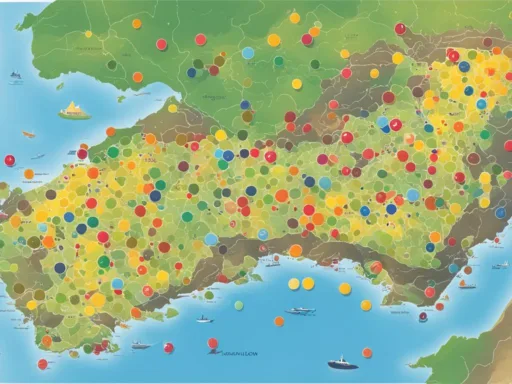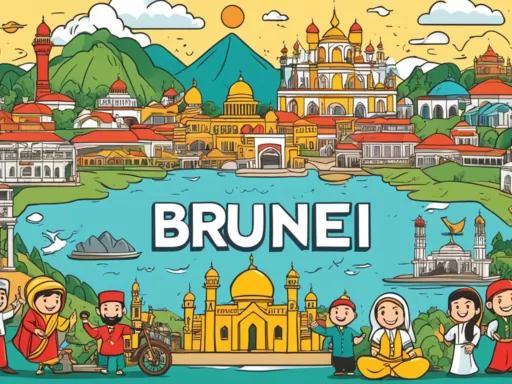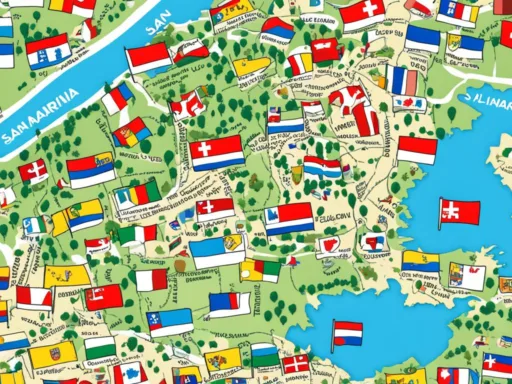Scattered off the coast of France, the Channel Islands are a showcase of linguistic diversity that belies their compact size. Here, a symphony of languages spoken in the Channel Islands narrates a history of cultural intercourse and changing sovereignties. The contemporary linguistic scene is dominated by English, but dig a little deeper and you’ll encounter a vibrant tapestry of regional and historic tongues, from official French proclamations to the whispers of Norman dialects that haunt the countryside.
For those curious about the language milieu of this archipelago, the official languages are French and English. However, it’s English that is increasingly heard in the cities and rural hamlets. Yet, amidst this Anglicization, the pulse of the Channel Islands’ languages beats with the remnants of a Norman past, found in the enduring dialects like Jèrriais in Jersey and Guernésiais in Guernsey, and even in the whispers of the nearly-forgotten tongues of Auregnais and Sercquiais.
While the fabric of Channel Islands languages has changed through the centuries, it remains a telling tapestry of the identity and history of this enchanting region.
Key Takeaways
- The Channel Islands cultivate a wealth of linguistic diversity reflective of their rich history.
- While French was previously widespread, English now predominates as the language of choice.
- Norman-French dialects endure, affirming the Channel Islands’ cultural uniqueness.
- The presence of both English and French signals the islands’ dual heritage.
- Language revitalization efforts are in motion to preserve the unique Channel Islands languages.
- The tapestry of languages spoken demonstrably enriches the Channel Islands’ cultural fabric.
Introduction to the Channel Islands’ Linguistic Landscape
The Channel Islands linguistic landscape is as varied and picturesque as the terrain itself. With English firmly established as the primary language, the islands nevertheless reflect a multilingualism that serves as a testament to their rich past and ongoing cultural interplay. Nestled off the coast of France, the Channel Islands are not just a geographic crossroads; they are also a linguistic melting pot, having fostered a diverse range of languages over centuries.
Jersey and Guernsey, the two largest islands, act as custodians of the region’s linguistic heritage, with each maintaining its own dialects of the ancient Norman tongue: Jèrriais and Guernésiais. These dialects, vestiges of a bygone era, serve as a cultural bridge connecting the present inhabitants to their historical roots in Normandy. The presence of such dialects within the contemporary Channel Islands linguistic landscape highlights a unique aspect of the islands’ identity.
Moreover, the Channel Islands are home to speakers of other linguistics heritages, echoing the storied past of these isles. Immigrant languages, primarily from Portugal, have recently added another layer to what can be described as a linguistic mosaic. They complement the historic association with the French language, arising from the islands’ proximity to France and their former governance under French administration.
Despite the Anglicization trends, the Channel Islands’ dedication to celebrating and preserving multilingualism is evident in the education and promotion of regional dialects. Below is an overview of the linguistic composition that encapsulates the multilingual heritage of the Channel Islands:
| Language/Dialect | Island Association | Speakers | Official Status | Cultural Significance |
|---|---|---|---|---|
| English | Jersey, Guernsey, Alderney, Sark | Widespread | Primary official language | Dominant in governance and daily life |
| French | Jersey, Guernsey | Limited | Secondary official language | Used in legal and ceremonial contexts |
| Jèrriais | Jersey | Minority, mostly older generation | Recognized regional language | Integral to local heritage |
| Guernésiais | Guernsey | Minority, cultural preservation | Recognized regional language | Historic language of Guernsey |
| Portuguese | Jersey, Guernsey | Significant minority | None | Reflects modern immigration patterns |
Given this tapestry of tongues, multilingualism in the Channel Islands is not just a relic of history, but a living, breathing element of daily life that enriches the islands’ cultural dimension. It acts as a bridge between epochs, linking the contemporary populace with their diverse linguistic forebears. This landscape of language provides an intriguing glimpse into the dynamic and multi-layered identity of the Channel Islands.
The Predominant Tongue: English and its Role in the Channel Islands
The Channel Islands, specks of land dotting the waters off the French coast, are a paradigm of language diversity and bilingualism. Despite an array of languages historically enriching the archipelago, English has firmly seated itself as the shared vernacular amongst its inhabitants. As the predominant language, English is a silk thread weaving through the governmental, educational, and socio-cultural fabric of the islands.
Being a British Crown dependency, the Channel Islands represent a unique blend of language diversity and British influence, having seen English rise to its current status as the official language. This is a language that opens doors to global discourse and connects these islands to a wider English-speaking audience, reinforcing the concept of bilingualism in the Channel Islands. The common sight of English in public signage, print and broadcast media, and its ubiquitous presence in educational settings underline its pervasive role.
Historically, the Channel Islands have retained a dual linguistic heritage, but the closeness to the United Kingdom and the global precedence of English have contributed to its ascension as the lingua franca. Across Jersey, Guernsey, Alderney, and Sark, even where Norman dialects whisper their centuries-old tales, it’s the English language that resonates in market squares and school corridors.

The footprints of English span across all spheres, from legislative chambers to local pubs, reflecting not just a practical choice but also a nuanced identity—the Channel Islands, while steeped in their Norman French legacy, have carved out a modern identity that is distinctly Anglophone.
Despite its prevalence, the Channel Islands’ authorities and its people have taken strides to preserve their linguistic inheritance, sparking waves of interest in the Channel Islands’ more obscure tongues. Such efforts showcase that while English may be the current predominant tongue, it coexists with an appreciation and respect for the islands’ rich tapestry of vernaculars. Indeed, in the Channel Islands, bilingualism doesn’t just refer to any two given languages; it’s a broader commitment to embracing their multilingual heritage. Thus, English in the Channel Islands is much more than a means of communication—it’s a lifeline to international waters, a bridge to its storied past, and a horizon of future potential.
Languages Spoken Channel Islands: A Dive into Regional Dialects
The Channel Islands languages are a rich mosaic of historical threads, weaving a narrative of cultural evolution and identity. With their Norman roots, these regional dialects form a distinctive segment of the language diversity Channel Islands are known for. While the prominent wave of English may be heard across the towns and rural stretches, there remains a fervent undercurrent of regional tongues that speak to the islands’ unique heritage.
Each island’s individual history is intricately tied to the specific Norman dialect it has fostered, making the preservation of these languages a matter of cultural significance. Despite their dwindling use among the younger population, dialects like Jèrriais in Jersey and Guernésiais in Guernsey carry the echoes of the past into the present, embodying the storied landscapes and traditions they emerged from.

The decline in active speakers of these regional dialects is a challenge for language conservationists, yet these languages continue to be celebrated for their unique linguistic features. They contribute not only to the cultural tapestry of the Channel Islands but also serve as crucial keys to unlocking the historical narrative of the region. Emphasizing the importance of these dialects is not merely an academic exercise; it’s a commitment to preserving the linguistic richness that the Channel Islands are privileged to possess.
- Jèrriais: Once the vernacular language of Jersey, now spoken by a minority, yet efforts for revitalization are ongoing.
- Guernésiais: The historic language of Guernsey, still retained as a cherished part of the island’s identity.
- Auregnais and Sercquiais: Though no longer widely spoken, they remain symbolic of the Channel Islands’ linguistic heritage.
In a bid to nurture these linguistic gems, several initiatives offer language courses, and local publications frequently feature segments in Jèrriais and Guernésiais. This dedication to supporting language diversity Channel Islands exemplify ensures that the region’s colorful past continues to be a significant part of its present and future narrative—a lesson in the preservation of linguistic diversity for small communities everywhere.
Norman Roots: The Influence of Jèrriais and Guernésiais
The Channel Islands, with their serene landscapes and profound history, also boast a rich linguistic tradition rooted in their Norman heritage. In particular, Jèrriais and Guernésiais are reflective of the distinct cultural identity that has been cultivated throughout the centuries. Emphasis on trilingualism in the Channel Islands, where these local languages coexist alongside English, has not only shaped local dialogues but has also offered a diverse experience for linguistic aficionados. Both languages, with their old-world charm and modern-day resilience, are more than just means of communication; they are living remnants of the islands’ Norman past.
A Brief History of Jèrriais
Jèrriais, the indigenous language of Jersey, has centuries-old origins that intertwine with the fabric of the island’s society. A testament to linguistic diversity, Jèrriais is a branch of the Romance languages and has played a crucial role in shaping the island’s identity, with its vocabulary and pronunciation marked by the ancient Norman settlers’ influence. Over time, Jèrriais evolved to be more than just a vernacular and endeared itself as an emblem of Jersey’s unique heritage.
Guernésiais: Preservation of Language
Guernésiais or Dgèrnésiais, as the native tongue of Guernsey, has historically sewn the social and cultural tapestry of the island. In contemporary times, it is an important facet of the island’s trilingualism, despite its speakers being in decline. The quest to preserve and revitalize Guernésiais resonates deeply with the community, underscoring a fierce determination to keep alive a language that encapsulates the heart of Guernsey’s Norman roots. Efforts are afoot to ensure that this channel of the Channel Islands’ heritage is not lost to the ages.

As these languages have transitioned through the eras, they have encountered both challenges and triumphs, which have only added to the allure of the Channel Islands’ linguistic allure. The impact of Jèrriais and Guernésiais is seen in local names, folklore, and daily conversations. It’s a heritage the islands are committed to safeguarding, as they recognize it as a vital thread in the fabric of their collective history and cultural identity.
Extinct and Endangered Languages: The Loss of Auregnais and Sercquiais
The rich tapestry of linguistic diversity Channel Islands harbor has experienced the sobering reality of language extinction. Names like Auregnais and Sercquiais, once spoken on Alderney and Sark respectively, are poignant reminders of the fragile nature of endangered languages Channel Islands. In a reflective pause, we delve into the stories of these languages that are now echoes of a vanished populace.

The Norman language of Alderney, Auregnais, recounts tales of a lingua once common but now silent forever. The deep loss felt with the passing of its last known native speaker around 1960 marked a somber point in the Islands’ linguistic history. But Auregnais was not alone in its fate. Sercquiais, an offspring of Jersey’s Jèrriais, teeters on the brink of extinction in Sark. With only an astoundingly limited number of native speakers remaining, the once-vibrant language now whispers its survival.
These language losses are not mere footnotes in historical accounts; they are an alarm to the vulnerability of cultural identity and linguistic heritage. The richness and diversity that endangered languages like Auregnais and Sercquiais lend to their communities are irreplaceable. As the world becomes ever more connected and homogenized, the disappearance of a language is akin to a living library being set ablaze.
The loss of a single language is like dropping a bomb on the Louvre. – Ken Hale, linguist
- **Auregnais (Alderney)** – Extinct since around 1960
- **Sercquiais (Sark)** – Endangered with under 20 native speakers
True to its commitment to celebrate and preserve its cultural gems, the Channel Islands recognize the critical importance of these languages. Despite their endangered status, efforts are being made to document and study the remnants of these languages, ensuring that their legacy continues and the consciousness of the Isle’s rich linguistic diversity is maintained. In the reflection of these endangered languages of the Channel Islands, we see not just the shadow of loss but also a call to action to cherish and protect the vibrant linguistic mosaic still remaining.
French in the Channel Islands: Official Status and Cultural Relevance
The mosaic of linguistic diversity Channel Islands house within their serene shores is not solely painted with the broad brush of English. French, an official language, garners a distinct respect and usage within the archipelago’s formal persona. While the rolling waves of English have gently eroded the everyday prominence of French, this foundational language has not receded entirely from the Channel Islands linguistic landscape.
In Guernsey, French flourished as the primary language until the mid-20th century and had been interwoven into the island’s administration and culture. Over in Jersey, French continues its legacy through the stately avenue of Jersey Legal French — a variant in legal use, safeguarding its perpetual relevance. These official usages of the French language serve as more than a vestigial element; they are ceremonial conduits and cultural signposts in the varied tapestry of bilingualism Channel Islands residents experience.

A conducive element to the ever-present French essence within these islands is the harmonious anthem of Jersey, “Ma Normandie,” which stirs up the French roots of the isle. Moreover, the footprints of history are marked by the influx of French speakers — be they entrepreneurial migrants or political refugees — all pooling into the Channel Islands’ storied annals, contributing to a rich linguistic and cultural inheritance.
The role of French in the Channel Islands underscores their multifaceted identity and stands as a testimony to the region’s storied past. Its incorporation in ceremonial and administrative contexts, its preservation in legal documents, and its resonant presence in cultural symbolism portray a language that is integral and indicative of the uniquely diverse heritage of the islands.
As we navigate through the linguistic diversity Channel Islands offer, it is essential to highlight the following significant touchpoints that underline the official status and cultural relevance of French in the local socio-linguistic fabric:
| Aspect of Relevance | Description |
|---|---|
| Official Language | French retains official language status in administration, especially in legal and state matters. |
| Cultural Significance | French is an integral part of Channel Islands heritage, as embodied by the anthem “Ma Normandie.” |
| Historical Presence | French-speaking populations contributed to the Channel Islands’ culture, influencing local dialects and traditions. |
| Educational Asset | French is preserved through academic avenues, promoting bilingual education. |
| Literary Tradition | Works in French by iconic figures like Victor Hugo have accentuated the literary landscape. |
Steeped in tradition yet adaptive to modern currents, French in the Channel Islands is a rich, flowing river of history that connects the present to a multilingual reality of yesteryears. It endures with elegance, contributing to the inherent diversity and cosmopolitan allure of this English Channel archipelago.
Multilingualism Channel Islands: The Impact of Immigration
As a fascinating microcosm of multilingualism, the Channel Islands are renowned for their diverse range of spoken languages, a richness to which immigration has significantly contributed. With waves of immigrants bringing their own tongues to these shores, the linguistic profile of the islands now includes voices from far beyond their Norman and British connections. In particular, the influx of Portuguese-speaking communities, primarily from Madeira, has added a vivid layer to the already varied Channel Islands languages.
These immigrants have not only shaped the local economy and culture but have also left an indelible mark on the islands’ linguistic tapestry. In Jersey, for instance, where a robust Portuguese community has taken root, their language is increasingly visible in day-to-day life. From public signage to community events, Portuguese plays a crucial role in the multilingual Channel Islands, offering proof of the dynamic and ever-evolving nature of language.
It is in the bustling streets, the humming cafes, and the colorful festivals that one can best observe the impact of this linguistic diversity. Here, English, French, Jèrriais, and now Portuguese intermingle, creating a cultural and linguistic mosaic that is as intriguing as it is welcoming. The integration of these communities and their languages reflects the openness of the Channel Islands to embrace new influences while honoring their heritage.
| Community | Language Spoken | Influence on Channel Islands |
|---|---|---|
| Portuguese | Portuguese | Visible in community communication and signage, enriching the local culture |
| British | English | Dominant in governance, education, and day-to-day discourse |
| Norman | Jèrriais, Guernésiais | Cultural preservation, part of the islands’ traditional heritage |
| French | French | Formal usage in legal and state matters, cultural ceremonies |
This vibrant snapshot of multilingualism in the Channel Islands attests to the islands’ historical propensity for linguistics, a crossroads of dialects and languages that maps out the complex identity of this unique region. What’s more, the embracing of new languages such as Portuguese continues to shape the evolving narrative of the Channel Islands, setting a compelling example of how communities can harmoniously blend voices old and new.
As we turn each street corner and hear the kaleidoscope of languages, it becomes clear that this environment of multilingualism Channel Islands style is not just a feature of the landscape but a cornerstone of the islands’ ethos. It stands as a testament to a place that values diversity and unity, offering each language—be it native, historical, or immigrant—a space to resonate and contribute to the collective story of the Channel Islands.
Conclusion
The vibrant quilt of Channel Islands languages is as intricate and multi-hued as the islands themselves. In this harmonious blend, the dominion of English intersects with a treasure trove of Norman dialects and the subtle undercurrents of French. This rich amalgamation encapsulates the islands’ compelling narrative—one that is deeply rooted in historical ties and shaped by the ebbs and flows of contemporary forces. Indeed, the kaleidoscope of linguistic diversity Channel Islands have nurtured stands as a beacon of the region’s adaptability and cultural wealth.
Our exploration revealed the resilience of the regional idioms such as Jèrriais and Guernésiais, evoking the spirit of preservation echoing through the archipelago. The linguistic diversity Channel Islands maintain is not a vestigial remnant, but a pulsating facet of everyday life, influencing everything from street signs to local literature, and signifying the community’s commitment to valuing every thread in its cultural tapestry. It is through these efforts that the islands have successfully managed to retain their unique identity, while simultaneously opening their arms to the global lexicon.
The ceaseless evolution of the languages spoken Channel Islands is equally marked by the profound impact of immigration, as new accents and dialects, predominantly Portuguese, are woven into the social mosaic. It paints a beautifully complex picture of a society that is as fluid as the seas that surround it, forever incorporating new linguistic patterns into its age-old heritage. The Channel Islands’ approach to multilingualism is a testament to the enduring human capacity for communication and connection in a rapidly globalizing world. It serves as an enduring reminder that language is not only a tool for dialogue, but also a cultural artifact worth cherishing, nurturing, and celebrating.
FAQ
What languages are spoken in the Channel Islands?
English is the primary language used in the Channel Islands for everyday communication and administration. Aside from English, Norman-French dialects such as Jèrriais in Jersey and Guernésiais in Guernsey are also part of the linguistic landscape. French has official status and continues to be used in a formal context, while languages like Portuguese are spoken within immigrant communities.
What is the Channel Islands’ linguistic landscape like?
The linguistic landscape of the Channel Islands is quite diverse, characterized by a mixture of English, Norman-French dialects, and French – each reflecting different aspects of the islands’ history and culture. Moreover, the influence of immigration has introduced additional languages and contributed to the islands’ multilingualism.
How has English become the predominant language in the Channel Islands?
English has increasingly become the dominant language due to historical ties with England, the influence of English-speaking settlers, and its status as the language of governance and education. Its prevalence has been reinforced by the British Crown dependency status of the islands.
What are the regional dialects spoken in the Channel Islands?
The regional dialects spoken include Jèrriais in Jersey and Guernésiais in Guernsey, which are Norman-French dialects reflecting the islands’ Norman heritage. The now-extinct Auregnais was spoken in Alderney, and Sercquiais, which is near extinction, is used on Sark.
How do Jèrriais and Guernésiais reflect the Norman roots of the Channel Islands?
Jèrriais and Guernésiais are indicative of the Channel Islands’ historical ties with Normandy in mainland France. As Norman dialects, they preserve unique linguistic features, traditions, and expressions, playing a crucial role in the local cultural identity and history.
What is the current status of the Auregnais and Sercquiais languages?
Auregnais, once spoken in Alderney, is now extinct, with the last native speakers passing away in the mid-20th century. Sercquiais, from Sark, is currently near extinction, with only a handful of native speakers remaining.
What role does the French language play in the Channel Islands today?
French maintains official language status in the Channel Islands. It is especially evident in Jersey’s administration, where Jersey Legal French is used, and in cultural elements like the national anthem “Ma Normandie.” French has been an essential part of the Channel Islands’ heritage due to historical and immigration reasons.
How has immigration affected the linguistic diversity of the Channel Islands?
Immigration has significantly added to the linguistic diversity of the Channel Islands, with the establishment of communities that speak different languages. For instance, there is a notable Portuguese-speaking community in Jersey, which has introduced Portuguese into the islands’ linguistic mix.






